How is defensive line play like a ballet? Big Ten's defending sack champ explains
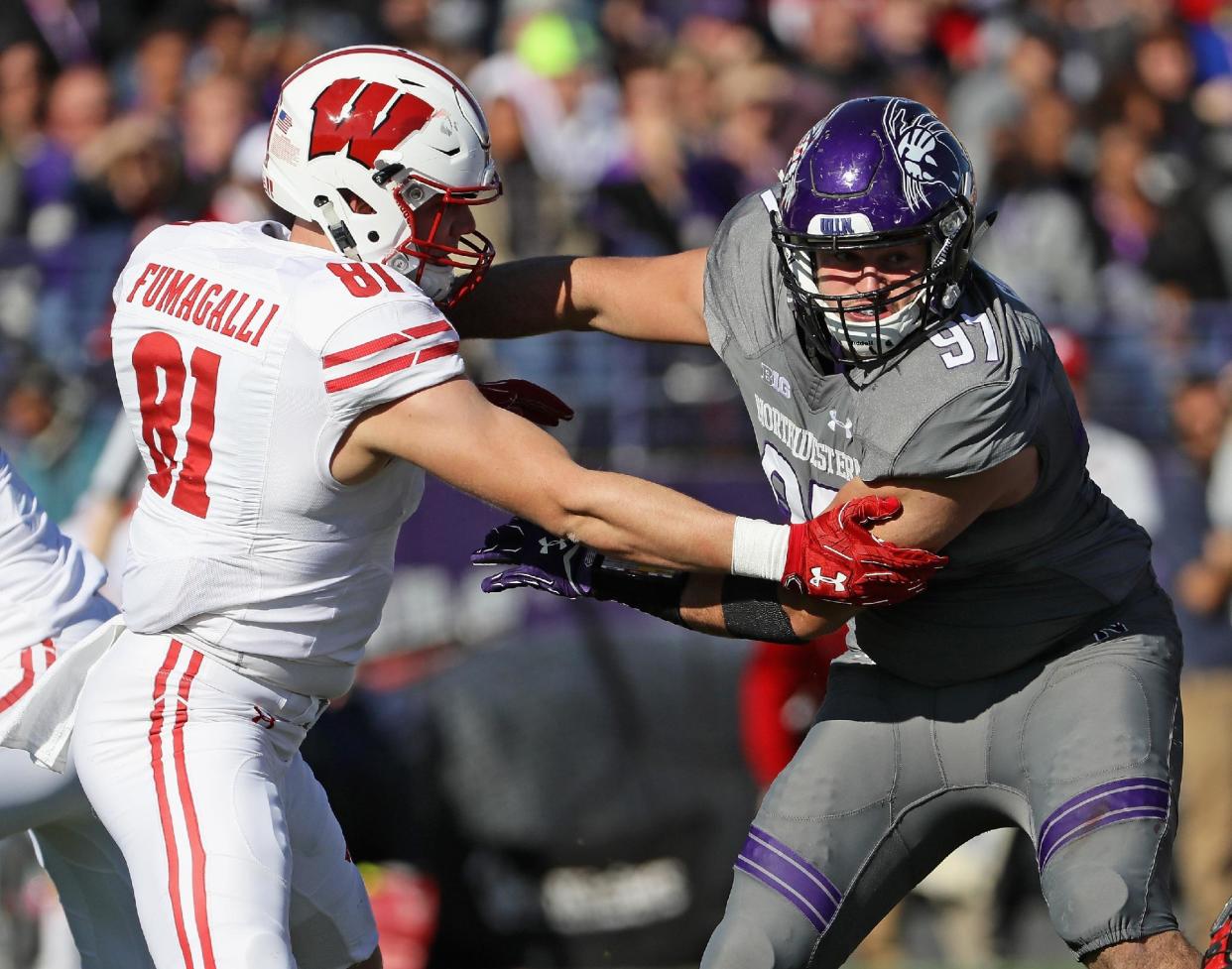
SCITUATE, Mass. – The mock drafts and magazine covers convey the message as subtle as a bull rush – this is the year of the defensive linemen in college football. Rarely has a position that’s been defiantly inelegant for decades found itself so much in vogue.
The players who operate in an area noted for anonymity – the trenches – and have a standard nickname demeaning their aesthetics – “Big Uglies” – have suddenly become central to the sport’s starring narrative.
ESPN analyst Todd McShay’s top three players in his first mock draft of the year – Houston’s Ed Oliver, Ohio State’s Nick Bosa and Michigan’s Rashan Gary – are all defensive linemen. Five of the top 10 and 11 of the top 32 players are defensive trenchmen. Three Clemson defensive linemen – Dexter Lawrence, Clelin Ferrell and Christian Wilkins – all project in the first round.
As the underexposed take their hand from the dirt for a rare opportunity in the spotlight, we felt it was important to engage an unknowing public to some of the nuances of defensive-line play. “It’s a ballet,” said Northwestern star defensive end Joe Gaziano. “But at the same time, it’s really physical.”
Much like a catwalk of famous defensive linemen, there’s a distinct paradox to balletic physicality. Gaziano, a 6-foot-4 and 280-pound redshirt junior from Scituate, Massachusetts, knows his way around a trench. He led the Big Ten in sacks last season (9), topping Bosa (8.5) and Michigan’s Chase Winovich (8).
To the uninitiated, line play has all the art of Sumo collision. But to the men whose skills are flashed anonymously in those trenches, each snap is an exercise in precision, a tango of sophisticated footwork, violent hand movements and well-timed hip flips. There’s gamesmanship on each snap, with positioning, hand strikes, step strategies and nuanced adjustments. Think of a cat-and-mouse game but played by hippos and rhinoceroses.
Gaziano’s biggest play of the 2017 season helped solidify Northwestern’s signature victory, a 39-31 triple-overtime stunner of Michigan State. Gaziano stripped Michigan State quarterback Brian Lewerke on the game’s final play, but didn’t even get credited with a sack. Lewerke recovered the fumble and threw an interception in the end zone, ending the game. The fans poured onto the field in celebration, but few appreciated the balletic beauty of that moment.
With Gaziano eager to showcase his refined skills in Northwestern’s opener against Purdue on Thursday night, here’s a look at the art of the duels in the trenches in five detailed steps. (And the extra one that happens when chaos ensues.)
1. THE SET-UP
“We stopped the run early in the game, so in the fourth quarter and overtime, they are passing the ball on second and long. What I’m doing is widening out, and it helps me because I play on the boundary side, so I have the three-technique next to me and the three-tech is covering that B-gap, so I have more room to widen out on the edge. So on this particular play, I widen more than I usually do. When you get a green light – GO! GO! GO! – I widen out a little more than I would, I’m tilting my hips so I’m not going straight upfield.”
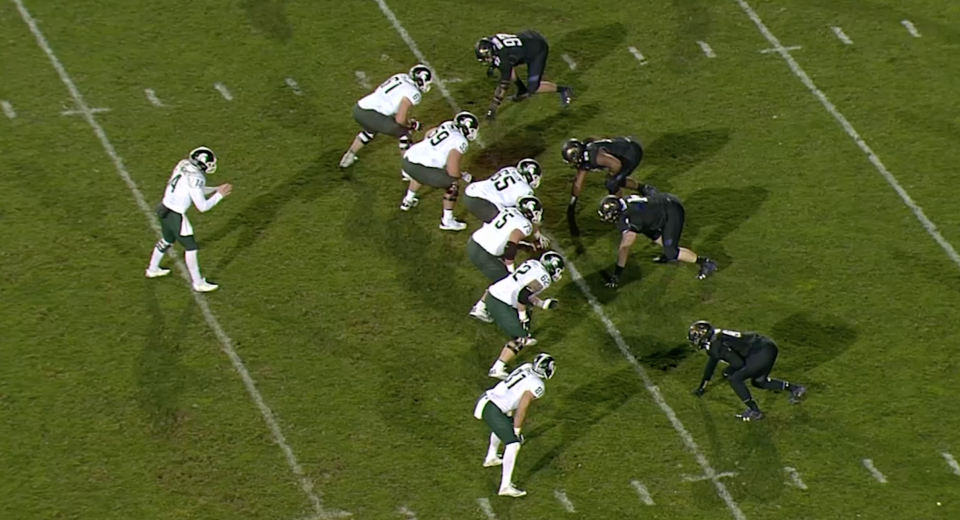
2. THE FIRST STEP
“When you’re closing in on an offensive tackle, realistically it’s going to be like three to three-and-a half steps to where you meet him at that spot. So your first step on that get-off, you need to be really, really long if you know it’s a pass. And the first step is huge because you don’t know the snap count, the offensive tackle does, so he automatically has a head start to that spot. The first step is all about getting triple extension on that back leg. You’re driving that front knee forward, and that back leg you want your hip, your knee and your ankle to be completely straight, you want it completely locked out because that’s when you get the maximum, you’re going to get the most power out of it, but you’re also going to get the most length out of it.”
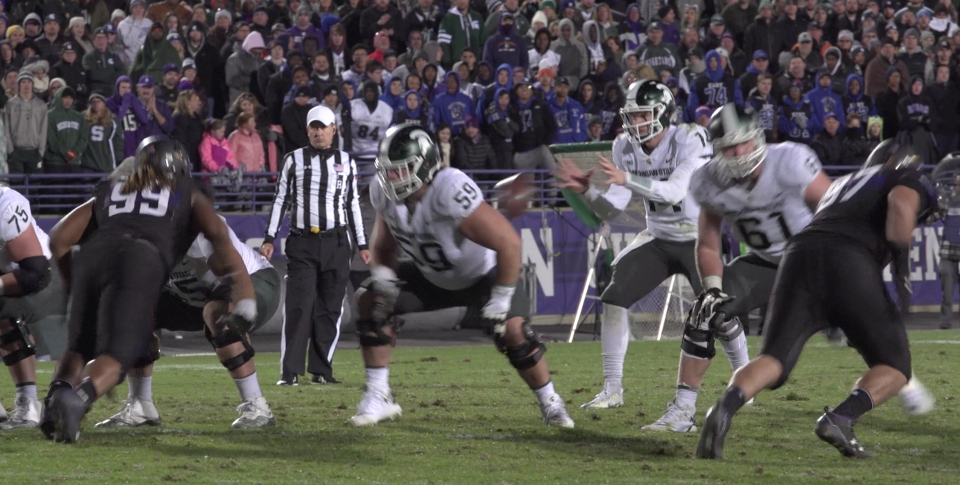
3. THE RACE TO THE SPOT
“We say beat him to the spot all the time. It’s basically a race. [The tackle is] going backward, you’re going laterally and forward. So the offensive tackle gets in his set and his back foot, which is staggered back about a yard and half, directly behind the front foot. That’s called “The Spot.” If he kicks, and he beats you there, then he already has the angle on it. But if you’re there first, then you already have position, you can get your hips around his outside hip and turn the corner.”
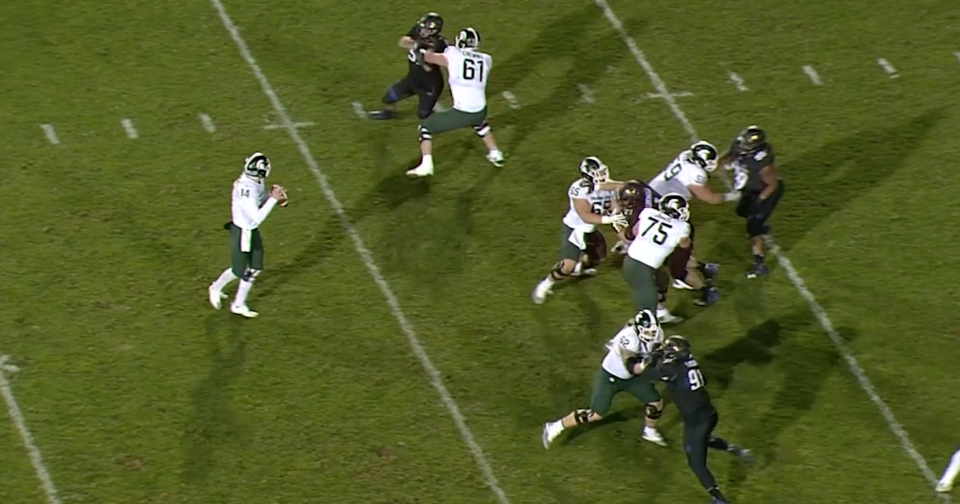
4. THE MOVE BEFORE THE MOVE
“A lot of reps in the game, I would go long arm (a common move that’s a thrust into the upper shoulder of the tackle) as a priority move. Michigan State had watched a lot of film on us and they were chopping, so when I would long arm, they would chop my arm. On this play, instead of going long arm, I switched up and showed him my arm so that he would punch, and go for the chop. Then I brought my outside arm and flipped around and hit him on the outside shoulder so that it gets his balance off, so that he’s set, he’s about to punch. That’s when I hit him here, he kind of has to freeze and his weight goes to his inside foot.”
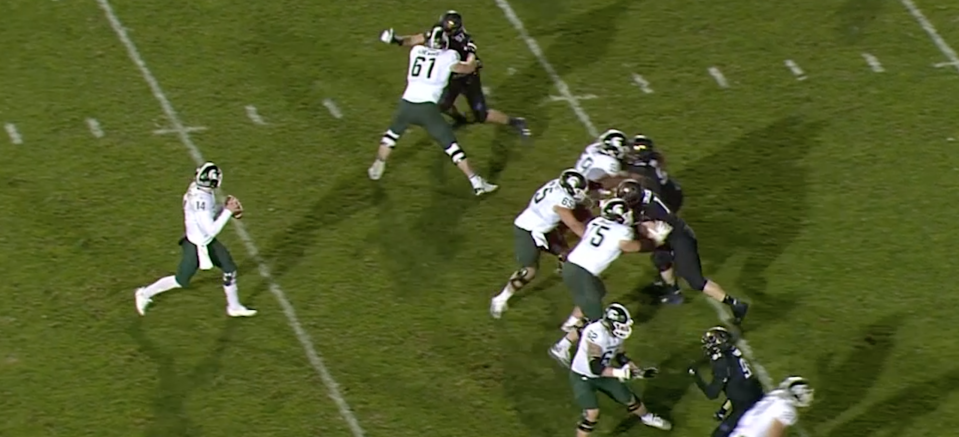
5. THE FINISHING MOVE
“So I make him stop and then I finish with a rip through so that he doesn’t have any surface area to recover with. So that if I just hit him here and kept running, my whole chest is open and he can bring his hands back in and set and take another kick, then punch and drive me out. But if I rip through, he has no surface area because I block with my outside arm. And at that point, because I was so wide I didn’t get to the quarterback level, I was just behind him but I was lucky enough where Lewerke was bringing the ball down on his throw. I knocked the ball down and it went flying.”
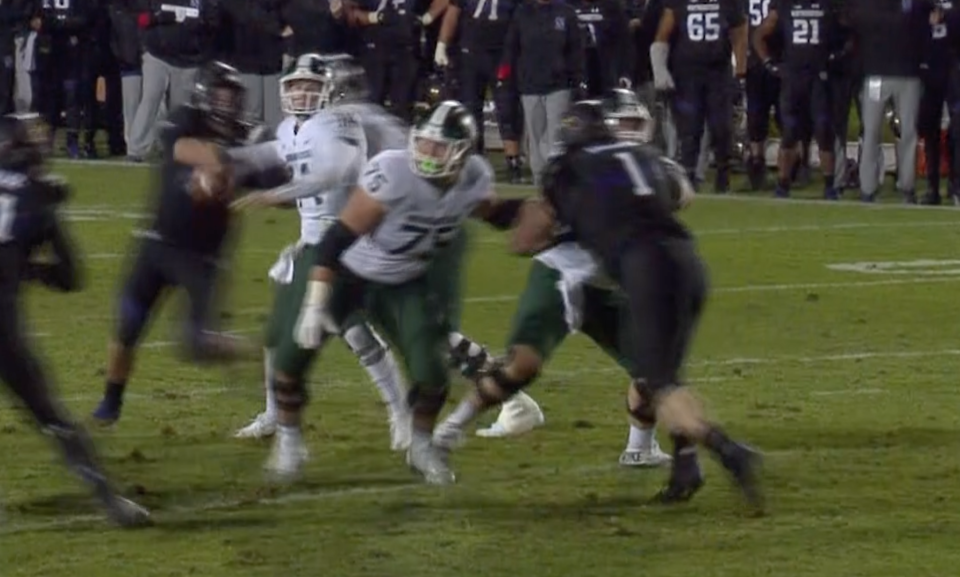
POSTSCRIPT
THE SCRAMBLE
“It’s triple overtime and we had just scored, and Coach [Pat Fitzgerald] was telling us before we went on the field: ‘If there’s a fumble, if there’s a pick, just go down.’ So I knocked the ball out and I knew that I knocked the ball out … I felt it come out, I felt bounce on the ground, and I felt it bounce the other way that I was going. I’m thinking to my linebackers or my D-tackles: Stay down! Stay down! Stay down! Don’t pick it up, don’t try and be a hero and all the sudden I look up and Lewerke has the ball and he ran over and picked the ball up, and I was like, Noooooo…
“The guard had peeled back, so he shielded me off, and so I couldn’t get to him and sack him again. Lewerke launches it and [Northwestern linebacker] Nate Hall comes down with it miraculously, and we end up winning the game. I didn’t get credit for a sack, but that was the most thrilling play of the entire year for me.
“By the end of the game, I was unbelievably gassed. You saw the fans rush onto the field, our whole team from the bench goes and mobs Nate Hall and they are jumping up on the goal post and all that. I’m trying to catch my air because I played 60-some-odd snaps and that was just like a crazy-long, developing play. So when everyone was jumping around celebrating, I’m on a knee trying to catch my breath.”
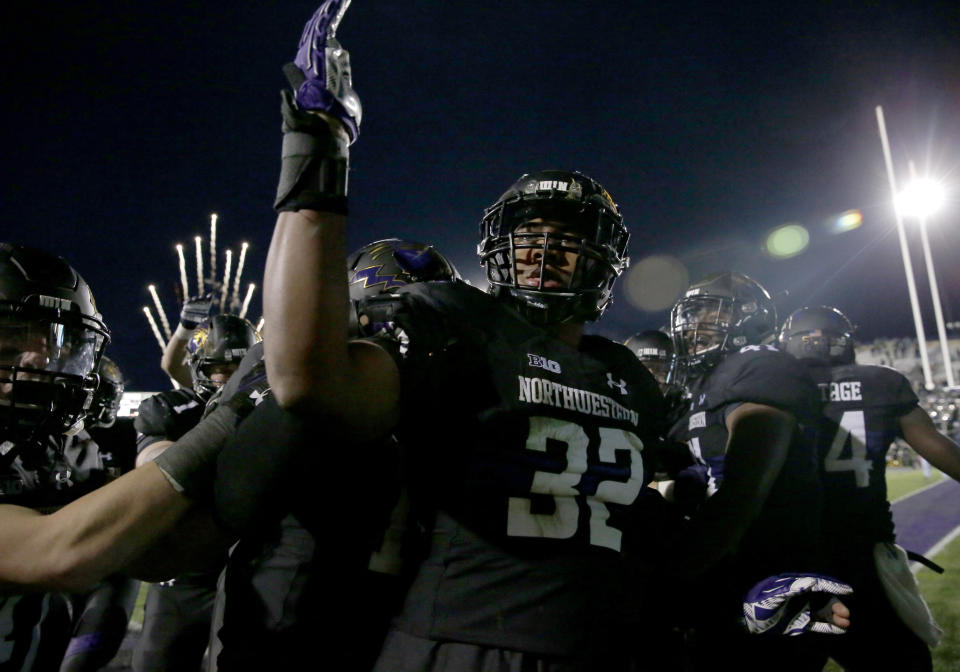
More from Yahoo Sports:
• Why an NFL QB left a $90M offer on the table
• Bob Costas may be headed to the NBC exit
• Steelers’ Bell on Labor Day return: ‘Fake news’
• LeBron, Curry could break NBA records this year

